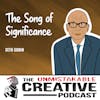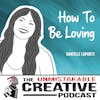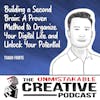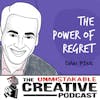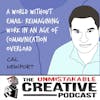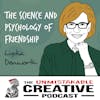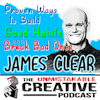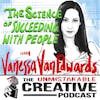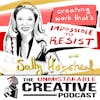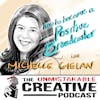Ross Symons | Exploring The Power of Creative Constraints Through Origami
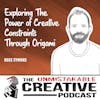
Ross Symons shares his journey of leaving his 9-to-5 job as a web developer to pursue his passion for origami and how he turned his hobby into a successful business.
Subscribe for ad-free interviews and bonus episodes https://plus.acast.com/s/the-unmistakable-creative-podcast.
Hosted on Acast. See acast.com/privacy for more information.
Ross, welcome to the Unmistakable Creative. Thanks so much for taking the time to join.
Ross Symons: F. Yeah. Thank you very much. Thanks for having me.
Srini: Yeah, it is my pleasure to have you here. I found out about you by way of your publicist who told me that you had basically made a career out of origami and about. . Nine years ago, Simon Sinek once told me, my why was that I was obsessed with people who were good at unusual things, which I thought sounded nonsensical at the time.
And then when I looked back at all the people we've interviewed, I thought, yeah, that makes complete sense. And so when I saw your pitch, I thought to myself, yep, this is somebody who was very good at something very unusual and made a career out of it. But before we get into all of that, I wanted to start asking you where were you born and raised and what impact did that end up having on what you've ended up doing with your life and your.
Ross Symons: two very separate answers I think there, but I'm from South Africa. I was born in South Africa grew up in Johannesburg, which is one of the biggest cities in South Africa itself. And in 2010 I moved, I studied, did a whole bunch of things up in, in Johannesburg, and 2010 I moved on to Cape Town is, and that's where I live at the moment.
And I guess growing up I was, just. A dude doing his thing and trying to work out who he is. And origami rocked up It just arrived randomly. It's not, I would love to say that I had this this idea to, one day become this paper artist or whatever. It's no I've done so many things in my life.
It was just a piece of paper that. I had in front of me my brother asked me to learn how to fold an origami crane, which is like the standard origami piece that people learn when they're starting
out
I did that in 2002 and yeah, just haven't really stopped since.
Srini: There couple things I wonder about, particularly being raised in South Africa, cuz I think I've had one or two South African guests and I'm not sure how old you are, but I'm curious if you grew up poster prea, apartheid.
Ross Symons: I'm 40 years old, so I was born, in apartheid, but it wa I was still young enough for it to not have, I'd say not have affected me. It's just I was too young to really understand what was going
on
I was, I guess in 1994 when when it was abolished and the whole sort of structure of,
South Africa, I guess changed.
The it was the beginning of the change. For the better. I was, I guess 12 years old only then did I realize okay, there was something different going on here that I didn't realize. And then later on, going into my teens and especially in my twenties, it became quite apparent that, what did happen in this country many years ago was just yeah. And just not cool at all. And being a white South African male, it's, it was it's diffi it's difficult to admit that, you were stereotypically part of that, although you didn't have a clue. As I say, part of it, I, was
just a kid growing up in, in this place that I was completely oblivious to what was going on and I couldn't re, couldn't really have done.
About it when I was younger, but I grew up in a family that was very accepting of, they didn't make a point of explaining to us what, when I say ask my brother and sister and myself that things were different. It
just
We just went on and accepted people for who they are.
And I think I'm quite grateful. To my parents for that because they just allowed us to make our own choices. It was never like, Ooh, what kind of people are you hanging out with? Or that sort of thing. And yeah, I think as a result of that, just made it easier for me to understand what was really going
on
Srini: Yeah. Did you have friends who weren't white when you were growing up, like during the apartheid period?
Ross Symons: I'll tell you a very interesting story. So there's a very famous a big sport in this country is rugby, which is I guess like your American football and the very first person of color I'll never forget this day, I was standing in, I was going into grade, what was that? It was 94, I guess grade
six
and.
We, it had just been, the change of the whole kind of climate. And it was now the schools were accepting people of color and kids across the board said it wasn't really a thing anymore. Not like we got told, okay, look, there's gonna be people that are a little bit different.
It just happened. And I remember standing at the back of the queue going into my first class, and there was this guy introduced himself to me. His name was Brian. Aana and Brian Aana was a colored guy from one of the sort of suburbs in in Johannesburg. And he was the first friend I made that was part of that whole, me making friends with someone that wasn't wasn't a white person.
And him and I stayed friends for years and he became like a very famous rugby player. But that was my first interaction or my first yeah, I, yeah. Interaction with someone of color at. and it's not like I was like, oh I don't remember thinking, okay, this is strange. I was just like, this is just another kid.
I was a kid. It was yeah it wasn't really a thing but looking back, it was a big, I think for my parents and the adults around us, it must have been quite a big deal because, how do you navigate that? How do you understand what's going on? It's no one really, there's no rule book for it.
It's like these people that have been suppressed for And separated. We now have to bring them together. What does that look like? How do we, navigate through this? And we, and this country's still trying to do it. And but yeah, that was I guess, my first interaction and memory of
that
Yeah.
Srini: Give us a glimpse of what Apartheid was like for people who have only seen it probably through media or heard about it in books or, seen movies like Invictus. What was day-to-day life like during apartheid?
Ross Symons: For me, like I said, I was very young. I can't say I really I only know from, from the media again from what we've been shown and stories I've heard. And just the way, guess the way people react cuz it wasn't just, it wasn't this change in, okay, we are now all supposed to integrate and you, you have all these, we are referred to as the Rainbow Nation, so we have multiple, I think we have 11 official languages and that comes with different cultural differences.
And, you can't just throw that number of cultures into the same place and expect everybody to get on. It's, it just doesn't.
So I guess growing up it wasn't very I guess apparent that these things were going on, but, a as, as we, I guess as I got older and I started noticing, okay clearly it was a big deal and you could see that the way that the as a child was quite aware of what was going on.
I could see when, when the mood in the room changed. I'm a sensitive, creative person, so I'm just aware of what's going on around me I'd noticed that certain adults would. Adults of color would look at me as okay, I come from, I'm a being a white South African, it's like my father was potentially, he's is a white South African, like they would look at you and I, you would feel that and you would, it would be you didn't understand why, but, and then, the people that you did interact with were, accepting of the situation. They were like this is just kid can't really blame him because of the color of his skin for what the people who were the same color as him did many years ago to oppress.
People like us. So yeah, I guess it was I think for my parents, it must have been very different. My grandparents, they were in the thick of it, and it was also at the time. Later on in life you share the stories that no one really, was they were very much against it. But again, if you're a family and you're against something, do you do?
Do you just go and stand up against the government? Do you go and Walk around just telling everyone that they're wrong and trying to change things. There were people that did that. And, it's easy to just to, say that, this isn't the way that things should have gone or shouldn't have been, but to do something about it, very few people actually do something.
So it's there's not too much we can do about it Support where we can help out where we can and and just yeah, just try and be a good human being.
Srini: Yeah. Is South Africa polarized in the way? The United States is, here in the US slavery ended well over a hundred years ago, but we still have plenty of racism and our country is probably more polarized than it's ever been. And yet you have got this just melting pot of cultures. I know this because South Africa has tons of Indians as well.
Some of them have our podcast guests and I've had family members who've, worked in South Africa and lived there. Is the political landscape as polarized as it is here?
Ross Symons: Oh man, I wanna say no, but it's again, it, think it's gonna take a long time for. for the cultures to blend, I think in certain areas, I think in the bigger cities everyone's getting on and or at least trying to get on. And it's not this whole, attitude of we need to get on now and, we need to be friends because that's, I guess what.
Everybody wants, and everybody wants to get on,
but
It's just, it comes down to education. It comes down to and the, I guess the new the younger generation or the people that are younger now don't even really see it. It's you're going to schools where there's.
from all over the place. And, I think parents are very conscious of the fact that you, if you point, if you're pointing at it, if you're saying this person is a different color to you, they have a different attitude towards culture and different if you keep pointing out the differences, there are always gonna be differences.
And there was always gonna be some form of segregation in the person's mind. So I think a lot of the people. That I speak to are very conscious of it. And that's on a sort of very micro level, but on a macro level, there is a massive separation. In some parts. still small towns where you go to and you can feel the racism and it's, I'll be honest, sometimes it's embarrassing being, being a white person because you're you're part of the team that did a lot of damage many years ago. how do you expect us to react to you And I feel that I definitely feel not in, like I say, not in the big cities, but some parts of the country that I go to. I, yeah, I feel like an outsider, which, take it back 50 years. I'm sure that's exactly what they felt like.
Srini: Yeah. Speaking of education what was the narrative around your household about making your way in the world? Because I don't think origami artist is on the list of potential career paths for probably anybody.
Ross Symons: right at the bottom of the list. Ah, man. I'm still trying to work out how it all happened. I don't think I, I didn't do very well at school. Think I had some form of ADHD or concentration issues or, I don't know. I wasn't really diagnosed with it, but everything that everyone else was doing and everything that everyone else thought they were supposed to be doing and were doing, I just, I couldn't understand and I couldn't,
Just blend in.
I was a different kid. I was always telling weird jokes. I had a computer in front of me since I was at six or seven years old, so that I found, I guess some sort of comfort in that because I was just feeding the computer information and I was getting what I wanted back from it But dealing with people, it was different. But growing up, my parents just I guess if I was into, making music, which I loved I played guitar for many years. Or sitting in front of the computer for hours, at hours at a time whatever. Any, anything that I was interested in.
My, my parents always supported it, and there was no until the one day I wanted to go to film school . That was the, my, I think dad comes from a conservative background. He's a very smart man and he, but very structured in his approach to
life
I remember I wanted to go to film school. I just finished school.
I flunked my first year of university or college. I
think
Is what they call it in the states. And I was
like
I don't know what I'm doing. I was studying business management and so I was just trying to, I just did it because, I was told this is what you do after school, after high
school
I've met a friend who showed me a whole bunch of these cool movies and films, and I had, I'd been messing around with just, Creating content way before content was a thing. Making little animations in a flip book or writing little songs or just random stuff. And most of it was centered around the computer.
So whatever I could do with a computer, I would try and make things with it and I thought film school would be a good idea. So that was the only time I really. , challenged my father. I said, look dad, I want to go study film. And this was in, I guess 2002. And that was before. The internet had just become like a popular thing.
It was before Facebook, before content creation was everything. Before, the film industry, which in South Africa at the moment is a big deal. , there's a
,
lot of people coming out here to film. So it was just at the beginning of it. And I, he just said, not gonna happen cuz he was paying.
And I was like you know what dad? Okay, I'll go do something else. And I ended up going to hotel school for my sins of all things in all places. And I'd completed that degree just to, prove to myself and to my father that I could actually complete something because it would've been the first thing that I actually stuck out and completed successfully, which I. but all the while I was still doing creative stuff on the side. So where the origami thing came in, my bro, as I mentioned, my, my brother had a project going on when he was at he was at design
school
and he had to create a project where he got a small piece of something that was created by each person in his family.
And he asked me to learn how to fold an origami crane of all things. I have no idea why he asked me to do it. He's just fold a
paper
So I found, I think I found instructions in a book and folded that, and I
just
for some reason just did not stop. Whenever I had a square piece of paper in front of me or a beer bottle label, that was my thing.
I used to drink. If I had a beer in front of me, I'd tear the label off, tear it into a square and fold a little origami paper
crane
And yeah, that's where the fascination started. But the
going forward it took a long. Time before it actually started becoming something that I knew I had an aptitude for and I knew I was interested
in
Srini: Yeah. Do you know that instinct to create you mentioned that, when you had a computer, your sort of instinct was, what can I make with this? And that's funny because you and I share that. Anytime I see new technology, my first thought is, what can I make using this?
Ross Symons: Yeah,
exactly
Srini: than thinking, how could I, commercialize this in some way?
Where does that come from for you?
Ross Symons: Oh man I think the first, creative piece that I ever created, I must have been, I don't know, seven or eight years old And I wrote a little story on, it was I don't even know what the program are. It was some, what they would refer to as a word processing program on an ibm, I think it was an XT computer with a black and green screen, before it was colored screens.
And I remember sitting there typing out, it was a little story and my mom printed it out on, we had one of those old school dot matrix printers with the the printer paper, the holes on the side that used to make horrible. I remember her printing this out and she kept it for years. Actually
I would love to know if she still has it but I remember creating that, it was a short little story about a cowboy, something had a horse, and I don't remember what the story was, but I remember creating that and thinking I made this thing and. That, I guess that fascination or that interest in using, as you say, a piece of technology or whatever technology I had around me be it a keyboard, a music keyboard or a guitar or some sort of recording device. How do I make something with this that is, it doesn't have to have any value.
It was just the process of creating was always something that, that fascinated me yeah, and I've just been doing that.
Srini: Talk to me about origami in particular, because it's such a, unusual art form. Like I said, that's what intrigued me. I thought, okay, here's somebody who's good at something, somewhat unusual. I would've never imagined somebody could make a career out of it. But it just, Like the process of making origami things is something very detailed.
There's something about it that seems almost meditative. Describe that process to me. Like you have this piece of paper and then you turn it into something. Obviously the crane, I think, is the first thing that any of us sees. I think I, the only thing I ever managed to successfully make was a cube.
Ross Symons: . , that's pretty advanced
actually
I guess a paper jet is where a lot of people start, and you don't really consider that origami, but essentially it is, it's ri means to fold and gari or Kami comes from the Japanese word, which means paper. and essentially it is taking a piece of paper, generally a square sheet.
Usually the size doesn't matter, but generally origami sheets are I guess, 15 by 15 centimeters, I guess six six by
six inch
Just using folds, no glue, no scissors. Although some people do use
scissors that's
a completely different art
form
Essentially using the. Folding techniques, different techniques that you can apply and learn, which can be applied to many other things.
Anything that can fold
essentially
And then knowing design and I guess the process of it you can pretty much fold or create anything that that you allow your mind to, to come up with. And yes, meditative absolutely I also see it for me, I love. Adore puzzles. Love I really do.
And like whether it's a Rubik's cube or a riddle or a game where I have to solve whatever it is, it's, I think I realized lately that origami is that thing, because origami is the puzzle is how do I take this square sheet of paper using only folds to create something that is whatever a duck, a rabbit, a mountain, a motorbike.
And that I think is in that process is there's something very special for me. And I think, you could probably ask any artist, it's the same thing. They have a pencil and a piece of paper, and once you lock into that flow state, you just release and it just all, comes out. . Having said that though, origami design, I think what the favor I did myself was because I was so interested in it.
And again, I never really thought, okay, cool. I wanna become this origami artist. Even when I say it now, it's weird, , think it was, I knew that if I wanted to do this more regularly, because it made me feel good and I, I really enjoyed it and I, think I had, an understanding of it I had to learn how to design origami figures now, or folding origami. Seeing a tutorial online or finding something in a book and folding that, whatever it is, some design that somebody else has come up with and designing your own origami, those are two completely separate avenues that it moves essentially from, an art form into something a bit more of an en intern engineering or technical space. And me being the technical, guess having the technical mind that I do, being able to code working with a computer for as long as I have been and solving puzzles. I think that was just the right combination of origami is just the manifestation of all that, which is, creatively coming up
with
An idea.
Cool. I want to create a paper donkey or paper dragon. Here's the limitation. So there's the puzzle, which you have a piece of paper and you can only use these techniques, which is folding and see how close you get. And there's different techniques. I learned many different design techniques from origami artist around the world.
There's a very famous origami artist who's actually a Swiss South African guy. Who I met right at the beginning of my origami journey. And that to me was just, that was some intervention that happened there. I just happened to meet him. I stayed in touch with him. He taught me everything he knew and he, at the time, he was like the rockstar origami artist.
A guy named Sipo Mabo. And we became good friends and. , every time I had a technical question, questions that I couldn't find answers to, because the origami community is, you don't have a lot of origami artists around the world And I had very specific questions because I could see that he'd created something.
And I'm like, how do I do that? And instead of having to work through it and take months or weeks to try and work it out, I'd be like, Hey man, I saw you did this thing. How did you do that? And he would literally just, jump onto a call with me or point me in the right direction. So for me, that was an indication that You've got this connection, you have some sort of understanding of it, so let's just see how far you can take it and that, that was the beginning of that for
me
Srini: Yeah. What does a practice look like for somebody who is anami artist? What does the process of getting better at this look like? Because I think, most of us see this. I saw the things on your Instagram and I thought, so how in the hell is any of this possible with a piece of
paper
Ross Symons: Yeah, , I still look at that stuff sometimes. I'm like, wow, how does that even
happen
But I guess the process, it's just I guess it's like anything, you learn the basics. You learn from the masters you see what's possible in terms of you've got larger pieces of paper which can form, much more intricate designs.
But then you start with the stuff that I guess makes sense to you, the. The designs and and the artists that you can see are a little bit easier for you to imitate. And once you. Good at imitating what they do. Then you slowly start adjusting things and, taking references from, oh, I like what he did with the shape of this origami dog's body.
I know how to get that technique, but how do I turn that origami dog into an origami? I don't know dragon for example, I need to add wings. I need to, a lot of the time it's getting something that's already pretty close to it because you have, I don't wanna get too technical with the whole process of it, but you start with the square and then you fold that square into what you refer to as the.
and the base has in the right I guess in the right order. And with the right proportions, it has different appendages, which you refer to as flaps. And each of those flaps represent a different part of the animal. For example, if you fall the best way to explain it is if you're looking at a lion or a bear that's been hunted and you've just got the bear skin on the ground if you had to take a square piece of pavement, put it top of that bear, you'd have the head at the
top
Two front pores on legs spread out the back in the middle hind legs with a small tail. And those proportions are directly transferable to a, if you know how to do it, of course into folds on, onto a square sheet of paper. And those sort of axial lines that refer to you, refer to them as access lines. Those become, I guess the starting points of the base of what you want to design. So once you know how to create a base for anything and change the num number of appendages, maybe you like, I don't know, you wanna turn a bird into a Pegasus, it makes more sense to do that because a Pegasus or Pegasus is, a bird with four legs cuz it's already got wings, it's got a head and it's got a
tail
Yeah, and you that's just how I've thought about it. I'm, there are hundreds of ways. I'm by no means the mathematical, or extremely technical type of origami artists. Some people are able to look
at
Diagrams and draw very specific diagrams in computer programs, which they are computer programs which aid origami design, and they can to like very small points and degrees, know exactly where they need to make the next fold.
And I'm just not like that. . I've tried to learn how those artists do that kind of work, and I just, I it becomes too technical for me. And I think because I just enjoy the process more than. What I actually create. A lot of the designs I create, I end up throwing away. I tell my mom that sometimes and she's no, you shouldn't throw 'em away.
It's precious, it's art. I'm like the art for me is actually creating the thing so there's many ways to create. It's like anything. It's many ways to, to build a building or sculpt sculpture. But I just found that, the process that I use is find a reference, use it. Up until it's okay, cool, I understand how to get to this point. How do I take it from here to where I need to get it
to
Srini: . So even when you do things as complex as making a origami hummer, is that all done with just one piece of.
Ross Symons: Yeah. The, are you referring to the Hummer that you saw
on Instagram
Yeah. So that we'll get into , that's not actually origami. That's a whole AI mixture of origami. Yeah. But essentially those designs that you saw are definitely possible. So how you would start that is, you'd basically just, it wouldn't, essentially, that would be a different process entirely because it's, a lot more geometric, it's a lot more and a bit more solid.
So maybe taking something that looks like a car. G there must be at least 10 to 50 designs of origami cars taking that design. And then, okay, cool. How do I expand out? How do I get the wheels? How do I make the wheels fatter? How do I, extend the body? How do I make doors all possible and all possible from one single sheet of paper?
If you see, you can do yourself a favor if you're listening to this. , you, don't believe what I'm saying. You go see some of the stuff people have made from single sheets of paper it's still, I see some of it and it blows my mind because I know that it's possible because I've done things like that, but I still sometimes look at them at the designs and I'm like how is this possible?
Yes, it maybe has taken, six months of design. That particular fold took 60 hours to fold. But the fact that it's just one piece of paper, is still to me is is pretty mind blowing.
Srini: Yeah. As I'm listening
,
to you describe this process it sounds to me like the entire process is an exercise in thinking of with constraints.
Ross Symons: Yeah, absolutely. And I think, and it's, I've been thinking a lot about the. The constraints of origami. And I think that for me, that
is
I don't wanna say a true creative but that for me is the kind of creative that am I'm someone who can look around and be like, okay, cool, we've only got that, and that, and I've applied that to all walks of my life.
But
how do I take idea? I need to execute that. What do I have in front of me and how do I. To where I need to go by using the tools that I currently
have
And that has served me like really well because I can get, I as a creator, as a content creator, I need to get stuff out quickly. I need to be able to conceptualize shoot the animation designer, design origami, make sure the client's happy with it send it to. do a storyboard and all those things. It's I'm limited to, okay, I can only design from a square sheet of paper. this is the corporate ID or this is the brand's messaging. I need to fold a dragon. These are the colors, this is the shape. And, that's what I'm limited to. And I, I cannot veer from that or from those parameters. And origami is very much exactly that because. You start with one single square sheet of paper, you can use multiple sheets. There are people that do use sheets and it becomes like a modular or AAMI thing which you can, that I guess becomes a bit more you can get a bit more detail with
that
But yeah, within those constraints I find there's a lot of creativity that can happen and I think a lot of creative people think that
Srini: Yeah. I think there is something beautiful about having constraints around whatever you're doing because then you are forced to work within them. And I think that forces you to think in different ways. So I wonder like, how has this idea of thinking constraints impacted your thinking in other parts of your life?
Like when it comes to your business when it comes to, the work you do and everything else.
Ross Symons: Yeah, so I, I think. Knowing that I've been able to it's still, it. It took me a while to realize, okay, cool, I can do this thing that not too many other people can do and then I started thinking about what I didn't allow myself. One of the things I didn't allow myself to do was doubt myself. I just felt, okay, cool.
I'm gonna try and attempt to do this thing. I'm not gonna let what other people think or what other people tell me. I'm just gonna create something and put it. . And in doing that whole process of creating, putting it out there, getting feedback that feedback. Was something that just became very valuable because especially with creating content that you're putting out online, you're only as good as your only as good.
I say that in, in inverted commas as your last
post
People only remember you for the last post you created. But for me, it, and that became a big deal. It was like, I need to create. The next thing that's gonna, that's gonna make an impact or go viral or whatever the case is. But as soon as I dialed back and I was just like, look, let me just focus on what I'm trying to do here and just get the thing out and then I can move on to the next thing And in doing that, and also, being a developer, I used to be a computer program. I used to work in advertising for many years. Building websites and apps and within the constraints of you've got this amount of. These are the tools you have.
You've gotta get that website up by that day, and this is what you need to do and it needs to happen. Getting forced into that situation, which I hated, it really did help me a lot because it taught me, okay, cool, these are the constraints, these are the things that you can and can't do.
You don't have a lot of time, the client is breathing down the, the project manager's neck, so you need to this get the shit done as soon as. And do that sort of stuff quickly and move on to the next thing I think just helped with learning new software connecting with people understanding who I am as a person.
Just, and if you can take it all the way back to me, understanding how to fold a square sheet of paper into a duck or a rabbit, I guess I've just learned how to do things quickly and as efficiently as possible and, the next iteration of what I'm gonna create, I know I can do better.
I'm just in that state. I don't, I, perfection to me does not exist. It's done is always better than perfect. Put it out there, get the feedback. If it's bad, do better next time. If it's good, move on to the next thing. Yeah, I guess that's just my process and knowing that about myself and knowing how to use that as a I guess as a methodology I feel I can learn things a lot quicker and I get things done a lot quicker.
Srini: No, let's talk about AI because I think that, that was one thing that caught my attention when I looked at your Instagram feed was your sort of use of AI to aid you in origami, which, I would've never made the connection between those two things. And it's funny, Right now working on an ebook titled The Artificially Intelligent Creative, which is all about how AI can enhance our creative process.
And it's been really an interesting exploration of all the things that are possible. I think to me, the thing that is just beyond brilliant is the fact that your technical knowledge is ceasing to be a limitation and your ability to express yourself creativity.
Ross Symons: Yeah, exactly. And I think that, that, for someone who, you know, I clearly you, think similarly to me in that regard it's kinda like you've got these new tools and it's just fun to create and make and see where it goes. And it's, I think you have to be quite childlike in your approach because you're kinda like, wow, it's new, it's fun.
Let's just play with it. Let's just see what happens. Cause no one really knows what it is Even the creators of these tools, don't
they're creating. Stuff. And these, these monster, ways and methods of creating things so quickly. Why are we doing it ? Is it to, is it just because we need to create, or is there some sort of which a lot of people do think it's oh, it's the sinister, we are, it's gonna control everything and people are gonna lose their jobs and whatever.
But in the same way that the camera, did the. Get rid of many jobs. I don't know They were like it's just about adjusting. It's
about
learning and understanding what these tools can do. applying them and putting them into your workflow and process. And that's how I see it.
That's how I try and teach other people to do the same. I've got a lot of hate. The last sort of five or six posts that I've put on Instagram, people are like, Hey, man, followed you up until now. And I'm done now. And I understand. I get it. They see it as, there's a whole I.
of thought, I guess that's saying that a lot of these AI tools have stolen from other artists and they generating things that are plagiarized. And I'm not gonna go down that rabbit hole, but it's for me it's, these are new tools and like with anything there is gonna be some pushback. But I read a quote the other day that said or resisting technology doesn't stop its progress So you might as well just accept that this is the way things are. how to use them, apply them into your into your workflow and just try and get better at what you're doing and just have fun with it because it is that's what they're there
for
Srini: Yeah. Oh yeah. I have been baffled by all the sort of fun things I could do. And this is one I haven't actually published this yet, but my nephew, who was like three or four months old, every day I would sing, nineties hip hop songs to him, . And the song that made him laugh the most was Fresh Prince of Bel Air.
Just as, just for shits and giggles I put fresh princes of Bel. The lyrics from the original song into chat, G B T, and I was like, rewrite this as a song about a baby going to daycare because he was starting daycare when my was going back to work. And so it spit out a song called The Fresh Prince of Daycare, and I was like, You know what if I had a, I looked at these lyrics, I was like, I'm gonna hire a freelance rapper to actually record this song for me.
And I did. And my sister was like, this is amazing. And I was like, yeah, amazing. What? 40 bucks in a bit of AI can do. It's this really cool idea of, human AI collaboration. I think when you combine human creativity with the capabilities of ai, you get some really interesting things.
And then I turned it into an animated short, which I'm working on right now. , but, that kind of thing just wouldn't have even been possible a year or two ago. And that, that's, the way I see it, I'm just like, okay. Julian Smith who has mentored me and has been a former guest here, one of the things he'd said to me that always stuck with me about technology was he said, the question you have to ask yourself is, what does this make possible?
That wasn't before.
Ross Symons: Yeah, exactly. And that's, but yeah I just wanted to jump in there. The fact that you've done that whole process is it's amazing. It's and that is what people need to realize, that you don't need to have, even more so now, you don't have to have that many skills. You just have to have an idea and. Some sort of willingness to like let's see if we can create, A, brand new the Fresh Prince of Ballet rap
song
and use this tech. And I think the people that are having fun with it like you and I are, and many other, many others are doing the same. Though it, it's us that are, hopefully showing the rest of
The
people that are a little bit apprehensive and a little bit like, whoa, not so sure about
this
it can be fun and yes, is it gonna replace jobs? Absolutely. Is it gonna, is it gonna disrupt things? Yes. That's why these, that's we need that. We need disruption because otherwise, what are we here for? We're just gonna hang around and do the same thing and, post pictures of origami and.
Write books about the same thing. It's it ha this has to change and it's, it I get so, so excited about what what is coming and where we are now because it, for me, it is just it's mind blowing to see particularly the rate at which things are being created and people that, which you wouldn't specifically class.
Everybody's creative. Everyone has, some sort of creative
abilities
The stuff that people are creating now, it's just wow, how did you even do that? And I see it, and instead of being intimidated by it, I'm like, I'm inspired by it. And I'm like, cool. How do I use that in my thing There's a guy that I've recently linked up with on, on Instagram, a guy named Manu. Who is making amazing stuff and he's teaching people. And his whole mission is just to teach people that like, this is how you use this stuff And him and I are collaborating on some virtual reality stuff.
Which is a world that I never ev imagined I would ever go into. And now he's yo, he has these skills. Let's take your skills, my skills, put them in. , add some AI and see what happens. And it's crazy. It's crazy what's going on. But it, based on what you're doing there, like doing the animation stuff, so I'm intrigued as to what like that's gonna look like already in my head.
I'm like, oh, fresh principal, animated, short, like that adding a rapid to, it's like this
Srini: I'll show it to after we.
Ross Symons: is insane
Oh, amazing.
Srini: So yeah, I, that, that's one thing that caught my attention. Cuz I know that these are some of your latest posts. Like how have you been using it in your own process? I saw that you had done that time lapse video where you converted, videos into images, still images, and then you're using stable diffusion.
Then you turned it into a time lapse animation.
Ross Symons: . Yeah. So again, these, I think because it's still quite new and I the general public is it's all about chat G p T at the moment. So all these other tools which are, voice synthesizers and music makers and image text to image generators and video to video generators are, it's still very new and fresh for people.
So what I'm trying to do is just see how I can apply
it
to what I've already done being origami and stop frame animation. and how do I create something a little bit different and how do I speed that process
up
And for me it's just idea generation is just, it. It happens in a 10th of the time that I would usually take a storyboarding, if I need to send an animation idea or a concept to a client, a wh chat over email.
Cool. So that piece of paper's gonna slide in here and then this is gonna happen. I actually posted something about it on Instagram. It's this is how I would do story of an origami fox, and he's traveling through, I found something on Chatty p. told a little story and I was able to put a storyboard together in under an
hour which
is unheard of.
I would need to, firstly, you need to learn how to use Photoshop. You need to learn how to cut out images, very basic things, but that takes time. So if you don't have those skills, you don't need them. Now
,
if you have the idea, you. Pretty much type. Okay, cool. So if we have 10 frames or 10 key frames, which are the main frames in an animation it goes from frame one, which is a blank frame of a forest.
The next frame, a little fox walks in. You can use Darley or any text image generator and just type in. Vector fox walking in from the left into the screen in the style of, and bit a vector style or without trying to plagiarize art as you could choose Salvador Dali or or whatever.
For me, because my art is quite geometric, I just have to put in the style of geometry or some sort of vector-based imagery. And. Without having to know very many tools, you can create something that is. Able to hand over to a client or hand over to anybody that you're now trying to explain an idea, for whatever, it can be an explainer video.
It can be a, it can be a pitch for a, for an animated series,
anything And
you can get that down in, under an hour and send it to somebody and it's okay, we like the way that this goes. Can you change this? Can you do that? And then you're done and usually that process would be weeks.
Srini: Oh no,
Ross Symons: for me
Srini: Yeah, go ahead.
Sorry
Ross Symons: How I'm
Srini: Yeah, I
Ross Symons: That's how I'm using it. And, sorry,
man
And I think yeah, going forward I j I just I'm just trying to show people as much as possible how you can use these tools because people are scared. I'm speaking to a lot of people oh man, you feeding the enemy.
You, you're teaching this machine how to do all this shit and it's gonna eat us up. I'm like you need to relax. You need to just learn how to use it and try and move forward with your
life
Srini: Yeah, no I have turned podcast transcripts into comic strips using these tools. I think the key observation that you made was using these tools and applying them to the things that you're already doing is really where it come. What it comes down to, I think people don't realize because to your point, like ultimately the most valuable thing any creator does is spend time creating, but for the final product, there's almost always all this ancillary work that needs to get done.
Writing a book is a perfect example of this, right? You need editing, you need proofreading. But really what counts is the writing, and this really frees you up to focus on the thing that produces the most value, which is the writing.
Ross Symons: Exactly
And people just don't, for some reason they don't get it It's, I don't know, look it like I said, there's gonna be resistance. , there's always gonna be resistance, but the sooner it be, be it a creative person, or even if you're a lawyer or a mathematician or a coder, I've written pieces of code I, if I wanna, I literally created a webpage,
which was I
inter chatt, G P T I.
I just wanted to see how quickly it could generate something that in my previous life I know it would've taken me the good part of half a
day I
wanted to see, cool. How quick can this generator's like cool, create a WebP? Which is a a single page website with a home about
contact section and
a dinner with links at the top and it needs to be in a specific CSS style and five blah, blah.
Go. And it's about that thing out in under 30 seconds. I copied it and just to test it, I copied the whole thing, plugged it into a text editor, loaded the website up onto a browser and it was flawless and I was just, , here are We are in the, future. Ladies and gentlemen. This is just this is the way things are and it's,
Srini: Yeah. No, it's really I think, at first people do very goofy things. I remember when I first saw Dolly, I just started, putting in really stupid prompts to see what it came up with. And it wasn't until I started thinking, wait a minute, I could actually incorporate this into my blog posts and have illustrations to go along with it with my articles.
That's when everything changed, when I started to actually see practical uses for it. And more and more I just started documenting each of my practical use cases. And even, this book, the Artificially Intelligent Creative, I literally was using my note taking app mem, which has an AI feature called Smart Write and Edit.
and just, as an experiment, I was like, write a synopsis for a book called The Artificially Intelligent Creative. And it did, and I just had that note sitting there in my notes for probably a good three weeks. Then one afternoon I opened up the note and I was like, write a table of contents for this book.
And I think that was about a week and a half ago, and I'm almost finished writing the entire.
Ross Symons: Oh
Srini: because I had so many notes on AI that I had taken, and it uses my own notes so it doesn't sound like something that was written by a machine.
Ross Symons: yeah.
exactly. As a matter of interest what is, or who is that
book
aimed at? Is this just something
that you want
to get out there or do you have a specific
Srini: I think that what I want to aim for really is creatives who want to use AI to enhance their creative process and to create things they couldn't before. Because for example, as a podcaster, like I've created probably a thousand episodes and the ability to repurpose that content at scale in different formats, I think was what really?
Was the big appeal to me because I thought, wait a minute, I could take all these and I can create animations. I can create, comic strips because, we did an animated series about five years back with soul Pancake Rain Wilson's Company, and at that time it was prohibitively expensive to do animation and incredibly time consuming.
Now, to your point, I can take a transcript and put it into a tool like chat, g p t and say, okay, split this up into scenes for an animation with captions, and suggested illustrations. Even for the Fresh Prince of Daycare video, I literally had it give me what all the scene transitions should be based on the lyrics.
Ross Symons: amazing. Yeah. And it breaks it down to cool, two seconds,
three seconds, then
Srini: totally. You can get as detailed or as granular as you want. That's the beautiful thing.
Ross Symons: Yeah, exactly. And yeah. Again, my mind just races thinking like what? You can do all this
Srini: No I think that's the thing that people don't realize is the potential is limitless here.
Ross Symons: Yeah, exactly. I've got another question for you. If you were in my situation somebody who's, I think there's a lot of people in, when I say my situation, someone who started early on Instagram, who built up a bit of a following in a very niche specific thing and wanted to create or wanted to start a podcast of their own what advice would
you have for that person
Srini: I think that one is to focus specifically on a niche which I think you got nailed. I wouldn't do interviews, actually because I think the interview format is saturated, and I think if you were gonna do interviews, I would bring a different spin to it. Like I've always wanted to do an interview style show, and I've mentioned this before, where instead of interviewing the person, I would tell a person's story by interviewing people they knew the.
Ross Symons: That's a great idea.
Srini: I was like, I don't have the editing skills for this, but I realize now that, I have my amazing audio engineer, I could probably come to him with this. Another idea that I'm toying around with in terms of podcasts is I want to do a show called How they Met each Other which is all about couples meeting each other.
and I already have a pilot kind of scripted and ready to go, which we might drop in a couple weeks just as a test run. Cuz I, know, starting another podcast was never high on my list of priorities, but that was one podcast that I was like, you know what, this would actually be a lot of fun.
And so I think I would go away from the standard formats that you see and try to bring something very unusual to it. Like just a different spin on any, anything out there.
Ross Symons: Yeah that's some good advice. Yeah. I just think, I was just thinking you could create a, you could literally do a an ebook or something like using , use all the AI tools available. Tell a little story on how to teach. Yeah. I guess creatives or content creators on how to start a podcast.
Anyway, it's just me throwing
ideas around but
I really wanted to ask you that question, and that was some yeah. The fact that you said don't just do interviews because you're right.
It's
you do get valuable information from people and you do hear their story, but you can listen to, One or two podcasts of somebody.
I think I've listened to Jamie Fox being interviewed on more than
one
platform The story's the
Srini: Yep.
Ross Symons: Not taking anything away from his, from him, his story's amazing. But it's it gets old and that's why shows hot Ones or although that's not a podcast or even the Joe Rogan show, like they really.
Into the nitty gritty, although that's a very long format, but where there is something else going on and you don't really have the specific okay, so what, how did you get inspired? Or what does your process like? That definitely comes up. So yeah, that was just a very specific
question I had
Srini: Yeah. The end of the
day
I think that this is the thing that a lot of people miss is I've said this before, that audio is an entertainment medium first and an education medium second, and people miss that. Which is why you can't just take, 10 tips on how to grow your Facebook.
Following that would be a mind numbing podcast.
Ross Symons: Yeah, exactly. . Exactly. And the number of PDFs and links on how to do all that are dime a dozen. , but also, like speaking about just the, I guess the industry that you're in, like being podcast or a podcast is entertainment first, and then education. I've recently.
Come to realize that I thought, I was an artist. I thought I was this person creating stuff. And yeah, I'm an artist I'm a creative and doing the thing, but I've realized I'm inter I'm in entertainment.
I, create little videos that I want people to sit and watch over and over again that they feel something so that they maybe educated in some way.
With the AI stuff, that's what I've been doing. And I think once you realize what industry you're in, because a lot of people, I heard this a while. A lot of people don't know what industry they're in and they don't really understand that oh, yes, okay, I'm a designer, but you actually are an educator.
Or you're an author, but you're actually a researcher, whatever the case is. And I think once you, and I think that just takes a lot of time to be in. Doing whatever it is you're doing to come to that realization. And now recently for me, I'm like, oh, okay, I'm in entertainment. And back all the way back to the beginning of what I said where I wanted to go to film school.
I'm I've been making films because I know what a movie or a film or a short or episode of the Simpsons does to me. I wanna be able to do that for other people. And I think I have been trying to do that in a short, 15 second, 15 to 32nd animation using paper and stop motion animation with sound and adding a bit of humor to it.
So yeah, I just, I thought I'd share that because I don't think people realize that they are in a
specific industry
They think they're doing one thing, but when you realize, hang. , this is actually what I'm doing It becomes a lot easier for you to focus and also understand that this is coming from you and that's the only way, as far as I'm concerned, and as you're chasing the buck, which a lot of us are doing, but it's the only way or one of the sure ways of continuing with whatever it is you're doing And staying inspired and staying
creative
is knowing what you're actually
doing
Srini: Amazing. This has been fascinating. I have one final question for you, which is how we finish all
of our
interviews at the end. Take creative. What do you think it is to make somebody or something unmistakable?
Ross Symons: Did think
about this
to me,
it's
someone that's taken the time to create something that is unique. And unique Doesn't necessarily mean good or bad, it just means it. They have tried to create something that is
different
They've looked at everything around them and they're like, you know what?
I'm just gonna go and try and do this thing Even if the public says, listen, that was absolutely horrible. Some people are gonna like it, some people are not. So it's. For me, something unique. When I see something unique, even if it's weird there's, I get sent po we all get sent posts all the time about like why is this person doing it?
But if it makes you feel something or it makes you think a little bit, then it's unmistakably like that person that has taken the time and effort to that thing And for me that's pretty much what.
Srini: Yeah. Amazing. I can't thank you enough for taking the time to join us and share your story and your wisdom with our listeners. Where can people find out more about you, your work, and everything that you're up to?
Ross Symons: Cool. Thank you man. I really appreciate you having me on. Yeah. So my name is Ross Simons and you can find me on Instagram. My Instagram handle is at White on Rice. That's the brand that I have. White underscore on Rice white on rice.com. That's I respond to all my messages, my dms, my as many messages as possible.
So if you wanna chat, if you wanna talk creativity, AI, or AAMI or anything, just hit me up.
Srini: Amazing. And for everybody listening, we will wrap the show with that.
Candid Conversations: Elevate Your Thinking with Masters of Their Craft
Dive into a realm of transformative conversations, where wisdom from trailblazers who've shattered norms is at your fingertips. Learn from best-selling authors who've decoded productivity, and thought leaders who've sculpted the landscape of personal and professional growth. Unearth the secrets of successful entrepreneurs, delve into the science of habits, and explore the art of charisma. Each conversation is a journey, brimming with unexpected insights and practical wisdom that will ignite you
